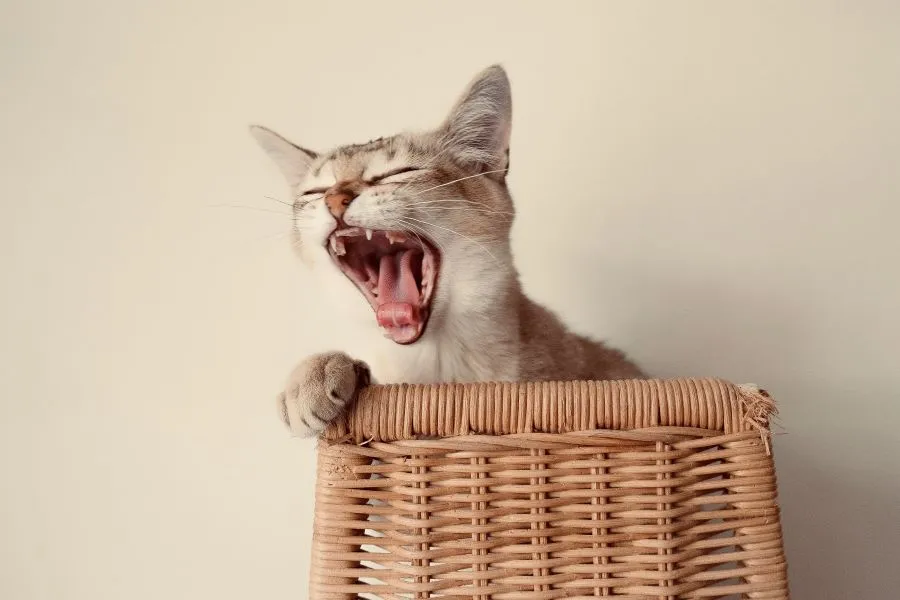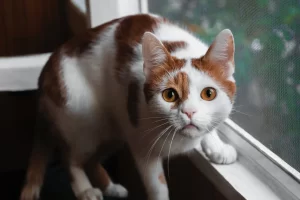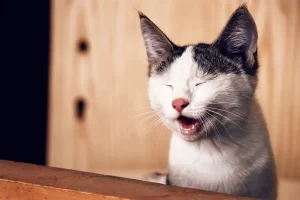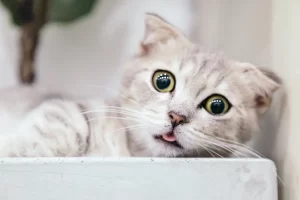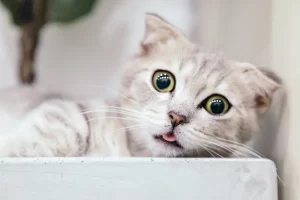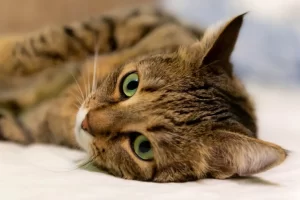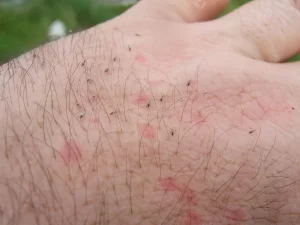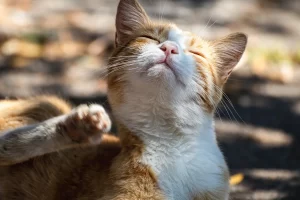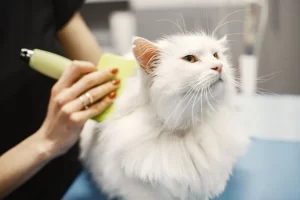As a cat owner, it can be distressing to see your feline friend experiencing bouts of vomiting. While there are various reasons why cats may be throwing up, ranging from hairballs to dietary issues, it’s natural to want to find effective solutions to help alleviate your cat’s discomfort. Fortunately, there are home remedies for cat vomiting that you can try before seeking veterinary care. In this article, we will explore natural solutions and practical tips that you can implement at home to manage and prevent cat vomiting. From dietary modifications to natural remedies, we will provide you with valuable insights to help your cat feel better and thrive. Read on to discover effective ways to care for your cat’s digestive health and well-being.
Table of Contents
ToggleWhy My Cat Keeps throwing up? Common Causes and Solutions
Cat vomiting or puking can be concerning for pet owners, and understanding the underlying causes is essential for effective management. There are several common reasons why cats may vomit, ranging from minor issues like hairballs and dietary indiscretion to more serious underlying medical conditions. In this section, we will delve into the top 10 causes of cat vomiting and discuss potential solutions to address them.
- Hairballs: Cats are meticulous groomers, and while grooming, they may ingest loose hair that forms into hairballs in their stomach. These hairballs can cause irritation and trigger vomiting. Regular grooming, brushing, and providing specialized hairball-control cat food can help prevent cat hairball vomit.
- Dietary Indiscretion: Cats are known to be curious and may eat something inappropriate, such as human food, plants, or foreign objects, which can upset their stomach and lead to vomiting. Keeping human food out of reach, offering a balanced and appropriate cat diet, and discouraging access to plants or objects that may be harmful can prevent dietary indiscretion-related vomiting.
- Food Allergies: Cats can develop food allergies or intolerances to certain ingredients in their diet, leading to puking after eating. Identifying and eliminating the allergenic ingredient from the cat’s diet, under veterinary guidance, can help manage food allergy-related vomiting.
- Gastroenteritis: Inflammation of the stomach and intestines, known as gastroenteritis, can be caused by various factors like infection, dietary changes, or stress. Dietary management, medication, and supportive care, as recommended by a veterinarian, can help resolve gastroenteritis and alleviate vomiting.
- Pancreatitis: Pancreatitis is inflammation of the pancreas and can cause vomiting in cats. Treatment typically involves medication, dietary changes, and close monitoring under veterinary supervision.
- Dental Issues: Cats with dental problems, such as gum disease or dental infections, may experience discomfort while eating, leading to vomiting. Regular dental care, including dental cleanings and providing dental-friendly food or dental chews, can help prevent dental-related vomiting. If the cat is vomiting and not eating, it may be because of different causes and may need different treatments.
- Intestinal Blockage: Cats can ingest foreign objects or develop masses in their intestines that can cause blockages, leading to vomiting. Surgical intervention may be required to remove the obstruction and resolve the vomiting.
- Metabolic Disorders: Certain metabolic disorders, such as kidney disease, liver disease, or hyperthyroidism, can cause vomiting in cats. Proper diagnosis and treatment of the underlying metabolic disorder by a veterinarian are crucial for managing vomiting associated with these conditions.
- Medication Side Effects: Some medications or treatments may have side effects that include vomiting in cats. Adjusting the medication dosage or changing to an alternative medication, as recommended by a veterinarian, may be necessary to address this issue.
- Stress or Anxiety: Cats are sensitive creatures, and stress or anxiety, caused by changes in the environment, routine, or social dynamics, can lead to vomiting. Providing a comforting and enriched environment, offering routine and stability, and using calming aids or supplements under veterinary guidance can help reduce stress-related vomiting.
Did you know that you can get an idea of the underlying cause of cat vomit from the vomit’s color? check out the cat vomit color chart and how you can decode the cat vomit color.
Cat Vomiting Symptoms and When to Seek Veterinary Care
As a cat owner, it’s crucial to be vigilant and recognize the signs and symptoms of cat or kitten vomiting. Cats may exhibit various symptoms when vomiting, including retching, coughing, or regurgitation. Understanding these symptoms and knowing when to seek veterinary care can help ensure prompt and appropriate treatment for your feline friend. In this section, we will delve into the common signs and symptoms of cat vomiting and provide guidance on when to seek veterinary attention.
- Retching: Retching is a common symptom of cat vomiting and is characterized by the cat making repetitive and exaggerated gagging or heaving motions without actually expelling any vomit. This may be accompanied by drooling or lip smacking. If your cat is drooling without vomiting, you may want to look into home remedies for cat drooling.
- Coughing: Cats may cough while vomiting, which can be a sign of irritation in the throat or respiratory tract as a result of the vomiting reflex.
- Regurgitation: Regurgitation is different from vomiting and involves the passive expulsion of undigested food or liquid from the mouth without any effort or retching. Cats may regurgitate food or liquid that hasn’t reached the stomach yet, which can be a sign of issues with swallowing or esophageal dysfunction.
- Abnormal sounds: Cats may make abnormal sounds, such as gagging, retching, or coughing noises, during vomiting.
- Salivation: Increased salivation or drooling may occur during vomiting in cats.
- Changes in behavior: Cats may exhibit changes in behavior before or after vomiting, such as restlessness, lethargy, or decreased appetite.
- Abnormal appearance of vomit: The appearance of vomit can provide clues about the underlying cause. Vomit may contain undigested food, partially digested food, hairballs, or have a foamy appearance.
- Frequency and duration: Pay attention to the frequency and duration of vomiting episodes. If vomiting occurs frequently, persists for an extended period, or is associated with other concerning symptoms, it may indicate a more serious issue.
Vomiting in cats when to worry?
It’s important to understand different types of vomits and consult a veterinarian if your cat exhibits any of the following signs:
- Persistent or recurrent vomiting.
- Blood or bile in vomit.
- Difficulty breathing or choking during vomiting.
- Lethargy, weakness, or signs of distress.
- Changes in appetite, weight loss, or dehydration.
- Presence of abdominal pain, swelling, or discomfort.
- Regurgitation of undigested food or liquid.
- Ingestion of a foreign object or suspected poisoning.
- Any other concerning signs or symptoms.
Home Remedies for Mild Cat Vomiting: Tips for Managing Feline Upset Stomach at Home
Dealing with a cat that is experiencing mild vomiting can be concerning for any cat owner. While it’s important to seek veterinary care for persistent or severe vomiting, there are some home remedies that may help manage mild cases of cat vomiting. In this section, we will explore safe and effective home remedies that you can try to help alleviate your cat’s upset stomach and promote their overall well-being.
- Fasting: If your cat has just vomited, giving their stomach a rest by withholding food for a short period of time can be beneficial. Fasting for 12-24 hours allows the gastrointestinal tract to settle and may help reduce further episodes of vomiting. However, always consult with your veterinarian before initiating fasting, especially if your cat is a kitten, elderly, or has underlying health conditions.
- Small, frequent meals: After the fasting period, you can gradually reintroduce food by offering small, frequent meals throughout the day instead of one large meal. This can help prevent overeating and minimize the strain on your cat’s digestive system.
- Water: It’s essential to ensure that your cat has access to clean, fresh water at all times. Dehydration can worsen vomiting and may lead to further health complications. If your cat is reluctant to drink water, you can try offering ice chips, ice cubes, or diluting water with low-sodium chicken broth to encourage hydration.
- Dietary modifications: If your cat’s vomiting is suspected to be due to food allergies or sensitivities, you can try switching to a hypoallergenic or easily digestible diet. Your veterinarian can recommend appropriate options or provide guidance on preparing homemade meals for your cat.
- Environment and stress management: Cats or kittens can be sensitive to changes in their environment or routine, which may trigger vomiting. Keeping your cat’s living space clean, providing opportunities for mental stimulation and play, and minimizing stressors in their environment can help reduce the likelihood of vomiting.
- Hairball prevention: If hairballs are suspected to be the cause of your cat’s vomiting, regular grooming and brushing can help prevent excessive hair ingestion. Additionally, providing specialized cat hairball remedies or adding fiber supplements to their diet may help in managing hairballs.
- Probiotics: Probiotics are beneficial bacteria that can promote a healthy gut flora and aid in digestion. Your veterinarian can recommend suitable probiotic supplements for your cat, which may help in managing mild cases of vomiting.
Natural Remedies for Cat Vomiting
If you prefer using natural remedies for your cat’s health concerns, you may be interested in exploring herbal options for managing cat vomiting. While it’s important to consult with your veterinarian before trying any natural remedies, there are some herbs that are known for their potential benefits in alleviating mild cases of cat vomiting. In this section, we will delve into natural remedies that may help soothe your cat’s upset stomach and provide some tips and instructions for their safe use.
- Ginger: Ginger has been known for its anti-nausea properties and may help reduce vomiting in cats. You can offer your cat ginger in small amounts, either in fresh or powdered form. One option is to grate a small amount of fresh ginger and mix it with your cat’s food, or you can offer ginger tea by steeping a small piece of ginger in warm water and letting it cool before offering it to your cat. However, it’s important to note that ginger may not be well-tolerated by all cats, and some cats may have adverse reactions. Always start with small amounts and monitor your cat for any signs of discomfort or adverse effects, and discontinue use if any issues arise.
- Chamomile: Chamomile is known for its calming properties and may help soothe the gastrointestinal tract in cats. You can offer your cat chamomile tea, but make sure it’s caffeine-free and only offer a small amount. You can brew chamomile tea, let it cool, and offer it to your cat in a syringe or dropper. Alternatively, you can mix chamomile tea with your cat’s food. Again, it’s important to start with small amounts and monitor your cat for any signs of adverse reactions.
- Slippery Elm: Slippery elm is an herb known for its potential benefits in soothing the digestive tract in cats. It comes in powder form and can be mixed with water to form a gel-like substance that can coat the stomach and reduce inflammation. You can offer slippery elm to your cat by mixing a small amount with water and syringing it into your cat’s mouth or mixing it with food. It’s crucial to follow the dosing instructions provided by your veterinarian or the manufacturer, as improper dosing can lead to adverse effects.
- Peppermint: Peppermint is another herb that may help alleviate vomiting in cats due to its potential anti-inflammatory properties. You can offer your cat a small amount of peppermint tea, but make sure it’s caffeine-free and avoid using concentrated peppermint oil, as it can be toxic to cats. Peppermint should be used with caution, as some cats may have adverse reactions. Always start with small amounts and monitor your cat closely for any signs of discomfort or adverse effects.
Dietary Adjustments for Cat Vomiting: Tips for Reducing Food-Related Upset Stomachs
Diet plays a crucial role in the overall health and well-being of cats or kittens, and dietary modifications can be an effective approach in managing cat vomiting caused by food allergies or dietary indiscretion. In this section, we will explore dietary modifications that may help reduce cat puking after eating and provide tips and instructions for their safe implementation.
- Bland Diet: Offering a bland diet to your cat may help soothe their upset stomach and reduce vomiting. A bland diet typically consists of easily digestible foods, such as boiled chicken or turkey without skin or bones, and boiled white rice or pasta. You can offer small amounts of the bland diet to your cat in frequent meals throughout the day, gradually increasing the portion sizes as your cat’s condition improves. It’s important to consult with your veterinarian for specific recommendations on the duration and portion sizes of the bland diet, as it may vary depending on your cat’s individual needs.
- Sensitive Stomach Cat Food: Switching to a high-quality, sensitive stomach cat food may be beneficial for cats with food allergies or sensitivities that can cause vomiting. These specialized cat foods are formulated with easily digestible ingredients and may contain added fiber or prebiotics to support gastrointestinal health. Look for cat foods that are labeled as “sensitive stomach” or “limited ingredient” and consult with your veterinarian for specific recommendations based on your cat’s dietary needs.
- Gradual Diet Changes: When introducing any dietary modifications, it’s essential to make changes gradually to avoid further upsetting your cat’s stomach. Sudden dietary changes can trigger digestive upset and result in more vomiting. Start by mixing a small amount of the new food or bland diet with your cat’s regular food, gradually increasing the proportion of the new food over several days until your cat is solely on the new diet. This slow transition allows your cat’s digestive system to adjust to the changes more smoothly.
- Avoiding Table Scraps and Human Food: Cats have unique dietary needs, and human food, especially table scraps, can often cause digestive upset, leading to vomiting. Avoid offering table scraps or human food to your cat, as it may contain ingredients that can trigger vomiting or food allergies. Stick to a balanced and complete cat food diet recommended by your veterinarian.
- Feeding Schedule and Portion Control: Establishing a regular feeding schedule and practicing portion control may also help reduce cat vomiting. Avoid free-feeding and provide measured meals at specific times of the day to regulate your cat’s food intake. Overfeeding or allowing your cat to eat too quickly can cause digestive upset and vomiting. Consult with your veterinarian for the appropriate portion sizes and feeding schedule based on your cat’s age, weight, and activity level.
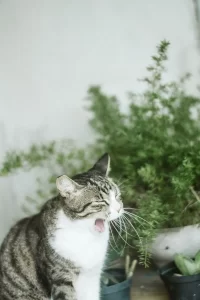
Managing Hairballs in Cats: Tips for Reducing Cat Vomiting
Hairballs are a common issue in cats, especially in long-haired breeds or cats that groom themselves excessively. Hairballs can cause puking and discomfort in cats, and managing them is essential to prevent related health issues. In this section, we will discuss strategies for managing hairballs in cats, including regular grooming, brushing, and dietary modifications to reduce cat vomiting caused by hairballs.
- Regular Grooming: Regular grooming can help prevent excessive shedding and the ingestion of loose hair, which can lead to hairballs. Brushing your cat’s coat regularly can help remove loose hair and prevent it from being swallowed during grooming. It’s important to use a comb or brush that is appropriate for your cat’s coat type to effectively remove loose hair. Grooming sessions can also be an opportunity for bonding with your cat and can help reduce their overall grooming behavior.
- Adding Fiber to the Diet: Adding fiber to your cat’s diet can help promote healthy digestion and reduce the formation of hairballs. Fiber acts as a natural laxative, helping to move ingested hair through the digestive tract instead of forming into hairballs. You can add fiber to your cat’s diet through specialized cat foods that are formulated with added fiber or by offering high-fiber treats or supplements as recommended by your veterinarian. It’s important to follow your veterinarian’s recommendations for the appropriate type and amount of fiber for your cat’s individual needs.
- Hairball Lubricant Products: Hairball lubricant products, such as petroleum-based or malt-based supplements, can help prevent hairballs by lubricating the digestive tract and promoting the passage of hair through the stool. These products are available in various forms, including gels, pastes, and treats, and can be used as directed by your veterinarian. It’s essential to choose hairball lubricant products that are specifically formulated for cats and to follow the recommended dosage instructions.
- Environmental Enrichment: Providing environmental enrichment for your cat or kittens can help reduce stress and excessive grooming behaviors that can lead to hairball formation. Cats often groom excessively when they are bored, anxious, or stressed, which can result in more ingested hair and increased risk of hairball formation. Provide your cat with toys, scratching posts, perches, and other environmental enrichment activities to keep them mentally and physically stimulated, reducing the likelihood of excessive grooming.
Treating Cat Vomiting Through Environmental Enrichment
Cats are highly sensitive to their environment, and stress or anxiety can manifest in various ways, including vomiting. Environmental enrichment plays a crucial role in promoting a cat’s mental and physical well-being and can help prevent throwing up caused by stress or behavioral issues. In this section, we will discuss the importance of providing a stimulating environment for cats and how it can help reduce cat vomiting associated with anxiety or behavioral issues.
- Safe and Comfortable Spaces: Provide cozy hiding spots, elevated perches, and comfortable resting areas for your cat to reduce stress and promote a sense of security.
- Play and Exercise: Regular play sessions with interactive toys, such as feather wands or laser pointers, can help reduce stress, provide mental stimulation, and prevent boredom. Provide scratching posts, climbing opportunities, and toys that encourage natural hunting behaviors.
- Environmental Stimuli: Provide window perches with a view of the outdoors, bird feeders, or cat-friendly plants like catnip or cat grass to keep your cat mentally stimulated and reduce stress. Use puzzle feeders or treat-dispensing toys during meal times.
- Litter Box Management: Keep the litter box clean, placed in a quiet and accessible location, and of an appropriate size and type. Have multiple litter boxes in different areas of your home to reduce stress and provide options for your cat.
- Minimizing Stress Triggers: Identify and minimize stress triggers in your cat’s environment, such as loud noises, changes in routine, or competition among multiple cats. Provide hiding spots or calming pheromone diffusers.
Preventing Cat Vomiting Through Proper Hydration
Proper hydration is crucial for maintaining the overall health and well-being of cats. Dehydration can lead to a variety of health issues, including vomiting. In this section, we will discuss the importance of keeping cats well-hydrated and how it can help prevent vomiting.
- Providing Clean Water: Always ensure that fresh, clean water is readily available for your cat at all times. Cats may be finicky about their water source, so consider offering different types of water, such as filtered or bottled water, to encourage them to drink more.
- Encouraging Water Intake: Some cats may not drink enough water on their own, especially if they are on a dry food diet. You can encourage water intake by offering wet food, adding water or low-sodium broth to their meals, or using water fountains or shallow water dishes that mimic their natural drinking preferences.
- Monitoring Urination: Keep an eye on your cat’s litter box habits and urine output. If you notice any changes, such as reduced urine volume or concentrated urine, it may indicate dehydration, and you should consult your veterinarian promptly.
- Recognizing Signs of Dehydration: Familiarize yourself with the signs of dehydration in cats, which may include dry gums, sunken eyes, lethargy, and loss of skin elasticity. If you suspect your cat is dehydrated, contact your veterinarian for immediate medical attention.
- Managing Medical Conditions: Certain medical conditions, such as kidney disease or urinary tract issues, can increase the risk of dehydration and vomiting in cats. Regular veterinary check-ups, appropriate medications, and dietary management can help prevent these conditions and reduce the risk of vomiting.
Cat Vomiting: Say No to Harmful Remedies
When it comes to managing cat vomiting at home, it’s important to be cautious and avoid using remedies that could potentially harm your feline companion. Some human medications, toxic plants, and home cleaning products can be toxic to cats and worsen their condition. In this section, we will highlight the importance of avoiding harmful remedies and keeping your cat safe.
- Human Medications: Never administer any human medications to your cat without the guidance of a veterinarian. Many over-the-counter medications, such as pain relievers, anti-nausea drugs, or antacids, can be toxic to cats and cause adverse reactions, including puking. Always consult your vet for appropriate medications specifically formulated for cats.
- Toxic Plants: Some common household plants, such as lilies, azaleas, or poinsettias, can be toxic to cats and cause vomiting or other health issues. Make sure to research and identify all the plants in your home and yard, and keep any toxic plants out of your cat’s reach.
- Home Cleaning Products: Cats are curious creatures and may come into contact with home cleaning products, which can be toxic and cause vomiting or other health problems. Use cat-safe cleaning products and keep all cleaning supplies securely stored away from your cat’s access.
- Herbal or Homeopathic Remedies: While some herbal or homeopathic remedies may seem natural, they can still have potential risks and interactions with your cat’s health. Always consult your veterinarian before using any herbal or homeopathic remedies for cat vomiting to ensure they are safe and appropriate for your cat.
Cat Vomiting: Recognizing Emergency Signs
Introduction: Cat vomiting can range from mild to severe, and in some cases, it may indicate an emergency that requires immediate veterinary care. It’s important for cat owners to be aware of the signs of severe vomiting that may indicate an emergency situation. In this section, we will discuss the red flags to watch for and emphasize the need for prompt veterinary attention in such cases.
- Persistent Vomiting: If your cat is vomiting repeatedly and unable to keep any food or water down, it may indicate a severe issue that requires immediate attention. Persistent vomiting can quickly lead to dehydration and electrolyte imbalances, which can be life-threatening, especially in kittens or senior cats. Contact your veterinarian immediately if your cat is unable to stop vomiting.
- Bloody Vomit: If you notice blood in your cat’s vomit, it can be a sign of a serious underlying condition, such as gastrointestinal bleeding or ingestion of a foreign object. Blood in vomit can appear as bright red or dark, coffee-ground-like material. If you observe blood in your cat’s puking, contact your veterinarian immediately for urgent evaluation and treatment.
- Lethargy or Weakness: If your cat is vomiting and also exhibiting signs of lethargy, weakness, or disorientation, it may indicate a more severe condition that requires immediate veterinary attention. Lethargy can be a sign of dehydration or an underlying medical issue that needs urgent diagnosis and treatment.
- Abdominal Pain: Cats experiencing severe vomiting may also exhibit signs of abdominal pain, such as vocalization, restlessness, or discomfort when touched around the abdomen. Abdominal pain can be indicative of an underlying issue that requires immediate veterinary care, such as intestinal obstruction or inflammation.

